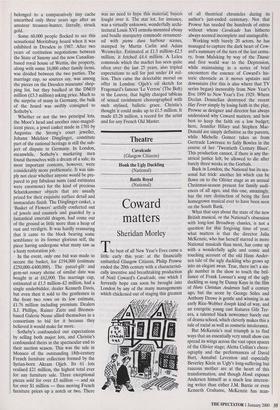Salerooms
Striking gold
Susan Moore
What was the last great object sold at the end of the millennium? A 17th-century silver-gilt marriage cup in the form of a near life-size Moor's head, crowned with a plumed headdress set with rock crystal. This unusually sculptural piece of virtuoso goldsmiths' work was an appealingly inter- national object too, having been made in Augsburg by Christoph Jamnitzer and probably commissioned to commemorate an important Florentine dynastic marriage in 1615. The only problem with this mag- nificent Schatzkammer trophy was that it looked as though it had spent the last 50 years buried in a forest in a gradually decomposing wooden crate. As indeed it had. Part of the spectacular collections accumulated by the electors and kings of Saxony and hastily hidden in the grounds of Schloss Moritzburg as the Red Army advanced on Dresden in 1945, the cup belonged to a comparatively tiny cache unearthed only three years ago after an amateur treasure-hunter, literally, struck gold.
Some 60,000 people flocked to see this sensational Moritzburg hoard when it was exhibited in Dresden in 1987. After two years of restitution negotiations between the State of Saxony and the now Canadian- based royal house of Wettin, the property, along with some 16,000 other family items, was divided between the two parties. The marriage cup, so sources say, was among the pieces on the Dresden museums' shop- ping list, but they baulked at the DM10 million (£3.3 million) asking price. Much to the surprise of many in Germany, the bulk of the hoard was swiftly consigned to Sotheby's. Whether or not the two principal lots, the Moor's head and another once-magnif- icent piece, a jewel casket made in 1701 by Augustus the Strong's court jeweller, Johann Melchior Dinglinger, constitute part of the national heritage is still the sub- ject of dispute in Germany. In London, meanwhile, Sotheby's marketing men found themselves with a dream of a sale; its most important contents, however, were considerably more problematic. It was sim- ply not clear whether anyone would be pre- pared to pay fabulous sums (and estimates were enormous) for the kind of precious Schatzkammer objects that are usually prized for their exquisite surface detail and immaculate finish. The Dinglinger casket, a `Basket of Flowers' artfully confected out of jewels and enamels and guarded by a fantastical emerald dragon, had come out of the ground as little more than a heap of rust and verdigris. It was hardly reassuring that it came to the block bearing some semblance to its former glorious self, the piece having undergone what many saw as a hasty restoration job.
In the event, only one bid was made to secure the basket, for £194,000 (estimate £250,0004400,000). The parcel-gilt and gem-set rosary shrine of similar date was bought in at £62,000. The marriage cup, estimated at £1.5 million–£2 million, had a single underbidder, dealer Kenneth Davis, but even then it sold to the gentlemen in the front two rows on its low estimate, £1.76 million including premium. Dealers S.J. Phillips, Rainer Zietz and Bremen- based Galerie Neuse allied themselves in a consortium to bid for it because they believed it would make far more.
Sotheby's confounded our expectations by selling both major lots, and Christie's confounded theirs in the spectacular end to their auction season. This was the sale in Monaco of the outstanding 18th-century French furniture collection formed by the Syrian-born Akram Ojjeh. Its 61 lots realised £21 million, the highest total ever for any furniture sale. Three exceptional pieces sold for over £3 million — and six for over $1 million — thus moving French furniture prices up a notch or two. There was no need to hype this material; buyers fought over it. The star lot, for instance, was a virtually unknown, wonderfully archi- tectural Louis XVI ormolu-mounted ebony and boulle marquetry commode ornament- ed with pietra dura harbour scenes, stamped by Martin Carlin and Adam Weisweiler. Estimated at £1.5 million–£2.5 million, it fetched £4.4 million. A Leleu commode which the market has seen quite often over the last 25 years, also tripled expectations to sell for just under £4 mil- lion. Then came the delectable morsel on offer in London: Ojjeh's oil sketch for Fragonard's famous 'Le Verrou' (The Bolt) in the Louvre, that highly charged tableau of sexual ravishment choreographed with such stylised, balletic grace. Christie's thought it could make up to £1.5 million. It made £5.28 million, a record for the artist and for any French Old Master.



















































 Previous page
Previous page